
FIFA Mobile
FIFA Mobile is a football (soccer) video game developed by Electronic Arts (EA) Canada for mobile devices. It features over 17,000 football players across 700 clubs in 30 different leagues that users can play with. Gameplay involves building and upgrading an ultimate team, competing in matches against friends as well as online players to climb leaderboards, and participating in live events that align with real world football events. In-game currency can be used both to train players and unlock new players in random card packs, and can be earned through gameplay or micro-transactions.
Polina Chzhan, Rollin Poe & Camerson Swanson | Semester-Long Project | Timeline: June 2020 (3 weeks)
Tools: Excel, R Studio, Figma, Keynote
FIFA Mobile
An user evaluation client project for Electronic Arts to understand the learnability and emotional frictions of FIFA Mobile’s onboarding.
Deliverables
See our final research report here & presentation deck here
Role
User Research, Usability Testing, Data Analysis, Project Manager
Value Proposition
Provoking player autonomy and freedom as well as educating the player on currency using incremental design changes that could help drive more player conversions for FIFA Mobile
Team
Polina Chzhan, Rollin Poe, Cameron Swanson
Timeline
June 2020 (3 weeks)
Tools
Excel, R Studio, Figma, Keynote
Problem Context
There was an identified opportunity to evaluate FIFA Mobile’s onboarding process due to the rich data potential from a player’s learnability and affective experience. The rationale behind the focus of studying the tutorial is that if players are confident in learning the game and have an emotional attachment from first gameplay, player conversion could be a resulting potential. Throughout the three-week research and design sprint, our team created a study plan, performed qualitative and quantitative data analysis, and redesigned the game mockups based on the findings.
“We would like to gain a holistic understanding of the onboarding process and ultimately our end goal is to bring in new players and convert them into spenders.”
-Tony, User Experience Design Director, Electronic Arts
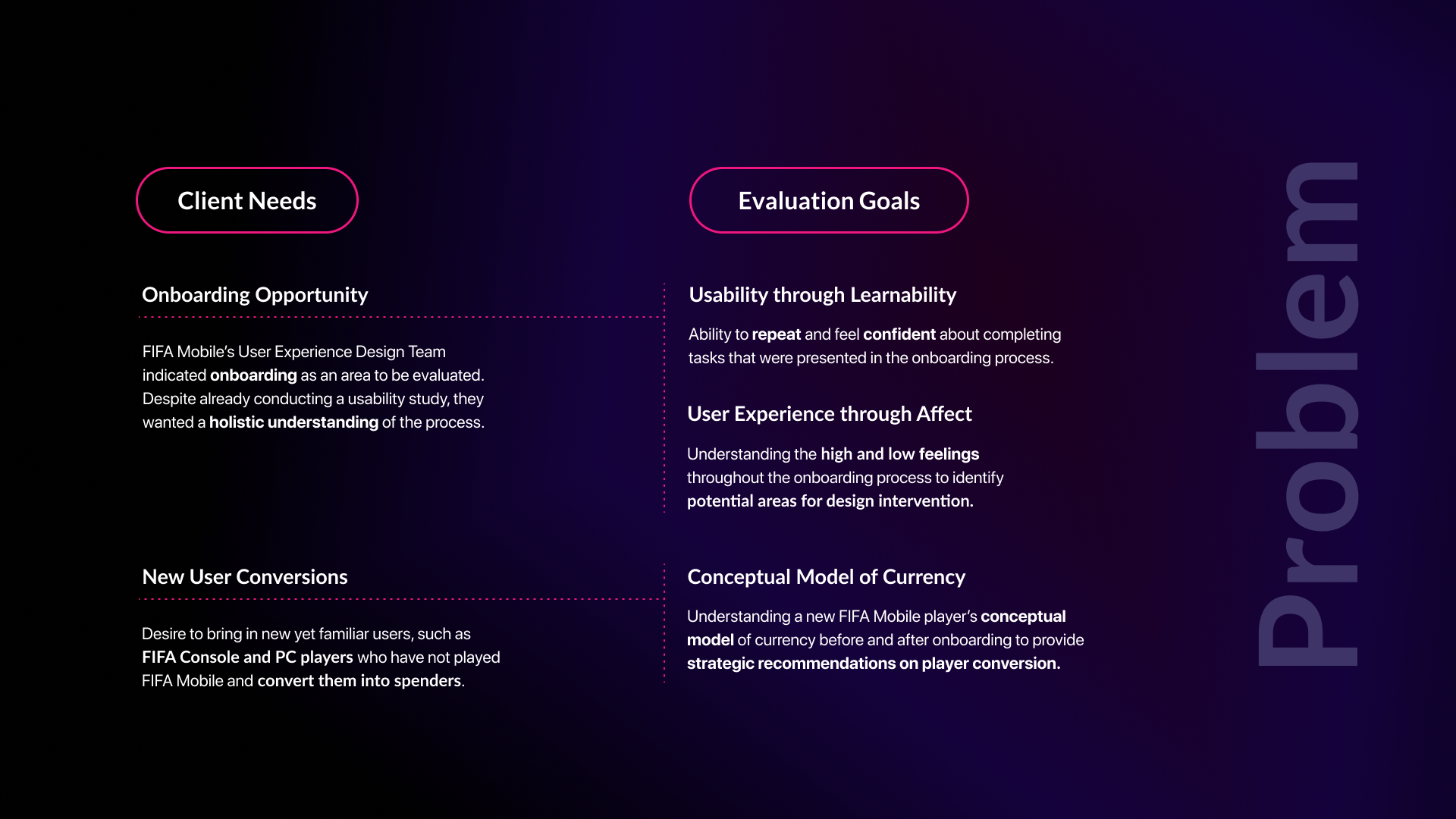
Participants
10 Canadian male participants were recruited, aged 18-25 who had an interest in football, had prior experience playing FIFA (i.e. console and PC) and have not played FIFA Mobile before. As per Jakob Nielsen, only 10 participants were necessary for testing, as the affective method used in this study could sufficiently capture a diverse range of player feelings and identify trends among participants.
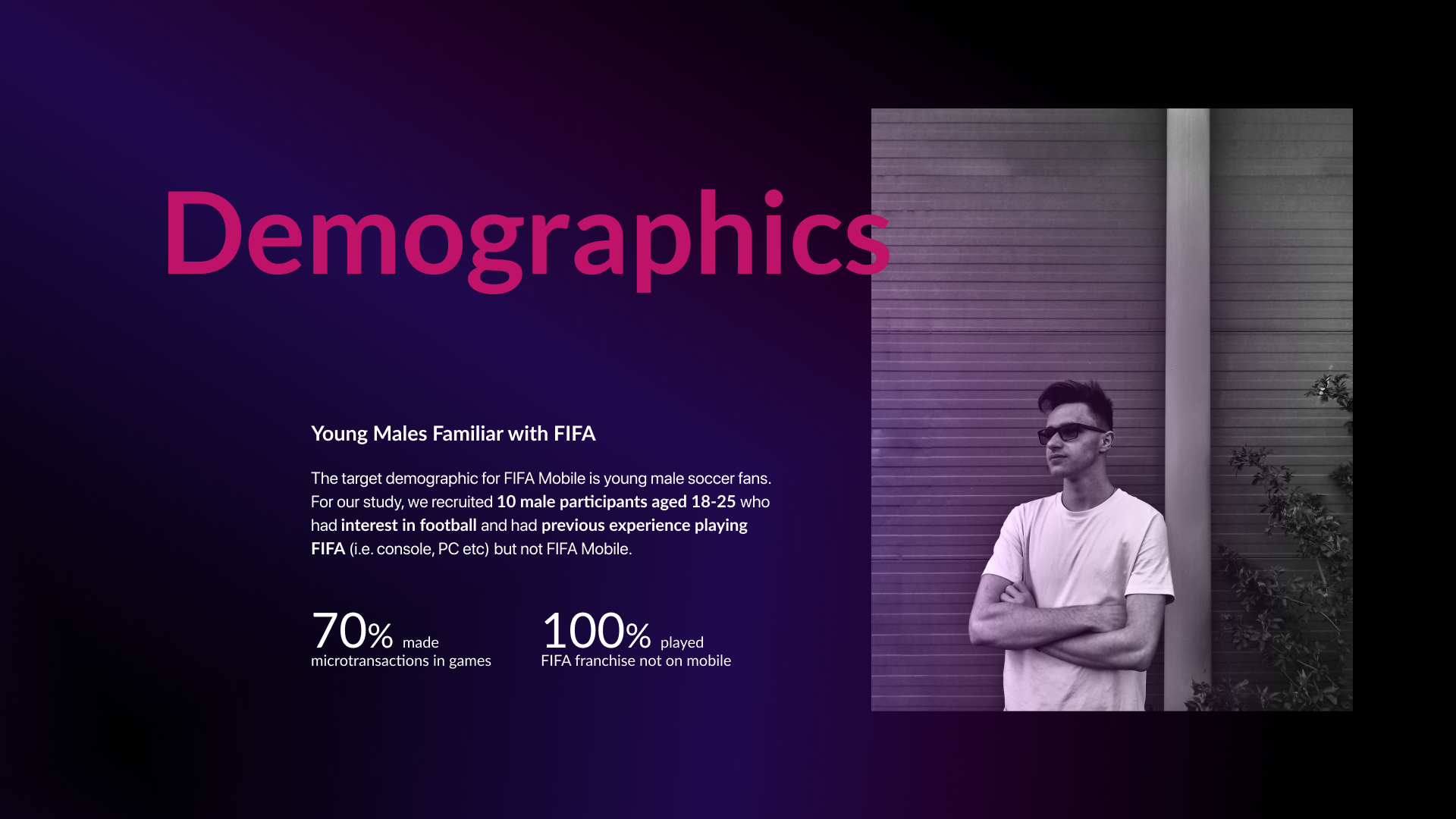
Study Methodology
We conducted the study in a three-tiered approach.
1. Pre-Play Questionnaire was sent to the participant to gage a player’s gaming background, experience with FIFA, and initial impressions of gameplay elements.
2. Then the facilitator engaged the participant with a Think Aloud technique to encourage them to express their actions, thoughts and feelings while going through the onboarding process. We recorded the participants’ mobile screen and audio using their default mobile screen recorder and Zoom for further analysis.
3. Lastly, a Post-Play Questionnaire was provisioned to evaluate the participants’ learnability/understanding of in-game elements using Likert-scale and rank-order questions.
Results
This led to three core insights.
Restricted Player Autonomy - how might we alleviate the player’s sense of frustration due to the strict tutorial structure and help them realize their autonomy sooner?
Visual and Interaction Disconnect within FIFA Franchise - how might we drive a more engaging visual language and interaction pattern by bridging consistency between the console and mobile experiences?
Confusion with Currency - how might we better educate the players on the currency system without sacrificing the player experience?
For the qualitative coding of the think aloud data, we uncovered three main themes which are rooted in reliable findings as the correlation coefficient is larger than 0.9: restricted player autonomy and freedom as participants felt frustrated that the onboarding restricted their ability to freely explore the game, particularly at the dribbling and store substages of the onboarding; visual and interaction disconnect between the FIFA Mobile and FIFA Console experiences which included currencies as well as in-game controls; and confusion surrounding the currency system as participants expressed that they did not understand the types of currencies that were awarded in each stage of the onboarding and how these affected their gameplay. An in-depth player affect Journey Map can be found below.
From the questionnaires, there was consistency in the restricted player autonomy finding as users expressed that the length of onboarding was too long and were frustrated by the amount of time that it takes to access gameplay. Additionally, they did not enjoy the number of steps that they were required to complete and wanted more control over the onboarding process.
“Lowlight was having to tap through and wait for the tutorial to load. Felt like it took 10 minutes longer than it should have.” - Participant 6
“It was pretty long and lengthy, I would rather explore this on my own.” - Participant 9
Data from the post-play questionnaire revealed that participants had moderately-high confidence in their ability to perform the various gameplay mechanics taught in the tutorial, indicating a relatively high transfer of knowledge and therefore learnability. A compared bar chart can be found below.
Comparing the data from the pre- and post-play questionnaires for the relative values for each in-game currency revealed that currencies that were used during the tutorial were ranked as more highly valuable than those that were not. For example, coins were most frequently rated as the most important in-game currency.
Redesign Mockup Proposals
Condensing the Onboarding Structure
By consolidating the shooting and passing into one stage as well as the dribble and defend stages into another stage, the intentionality is to reduce the player’s initial perception of a time-consuming onboarding process. This is a minimal design change that does not interfere too much within an experienced FIFA player’s familiarity with the FIFA onboarding experience.

Existing Gameplay State

Recommendation Proposal
Provoking Player Exploration
The consistent visual interaction cue was adopted to highlight areas of free-roam exploration on the main menu (i.e. Quests, World Tour and Events) to encourage the player to freely discover in-game content and to facilitate autonomy sooner in the game.
Reducing Player Errors
Participants skipped many dialogue boxes and became prone to making errors that increased frustration. Small animated gestures and the ability to reopen dialogue objective boxes can be added to aid error correction and thus, learnability.
Improving Knowledge About Currency
Using informational pop-up boxes or headers within reward screens and the store to inform the user about currency benefits can help promote discoverability as well as knowledge, and thus lead to the future likelihood of microtransactional purchasing behaviour.

Existing Reward Screen

Recommendation Proposal
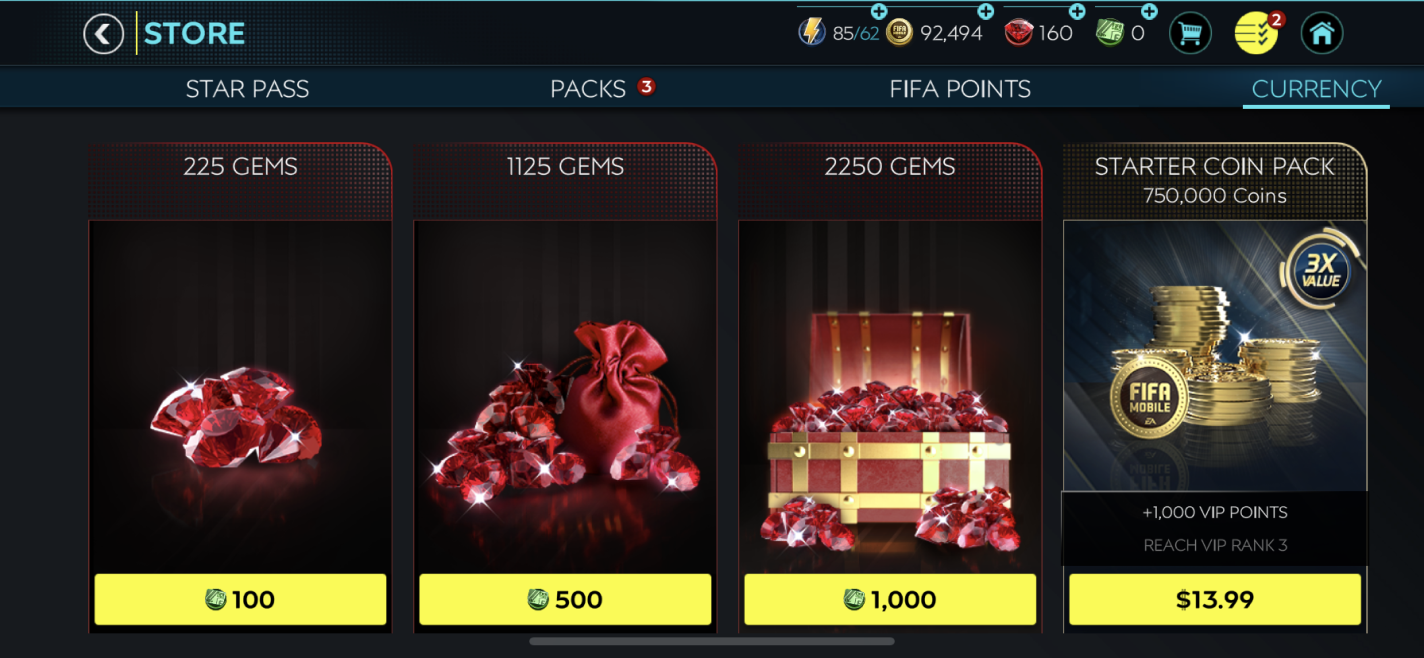
Existing Store Screen
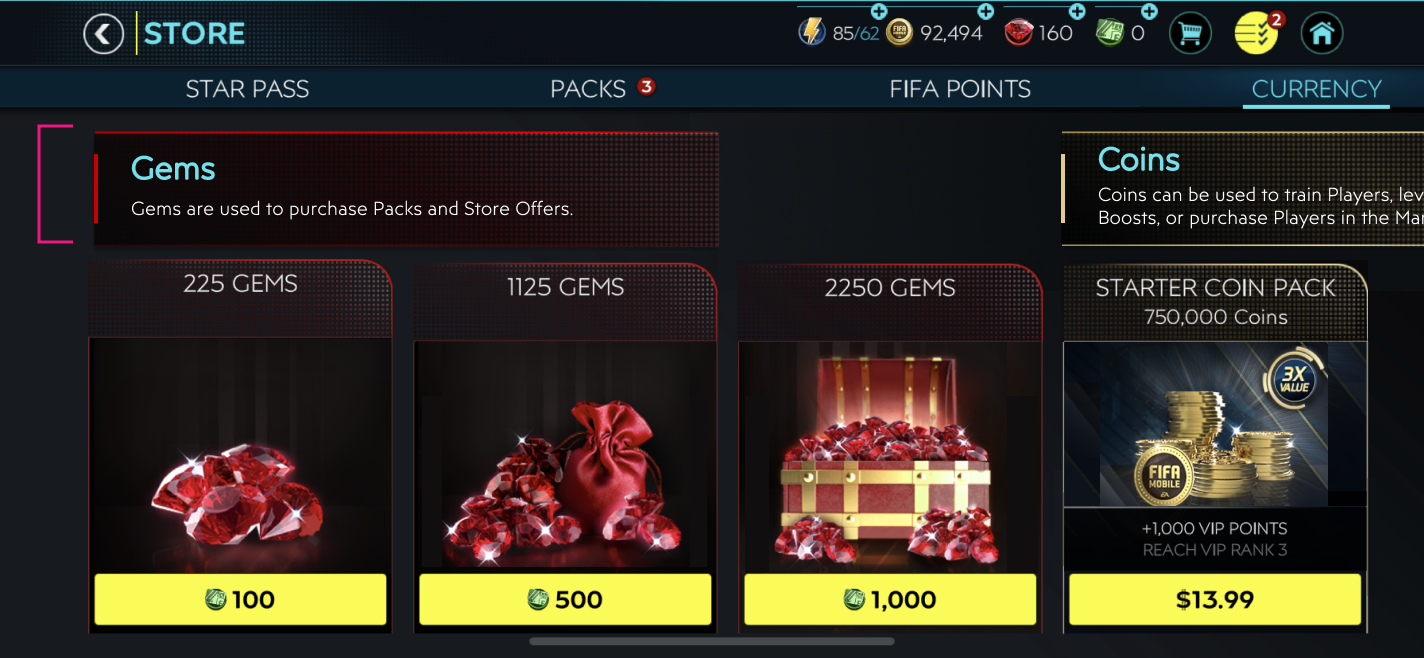
Recommendation Proposal
Increasing Player Conversion Rate
The contents of the Welcome Bundle were tailored using either currencies that familiar FIFA players have engaged with before (i.e. FIFA Points & Coins) or ensure that the currencies are introduced during the onboarding to ensure relevance to the player’s conceptual model.
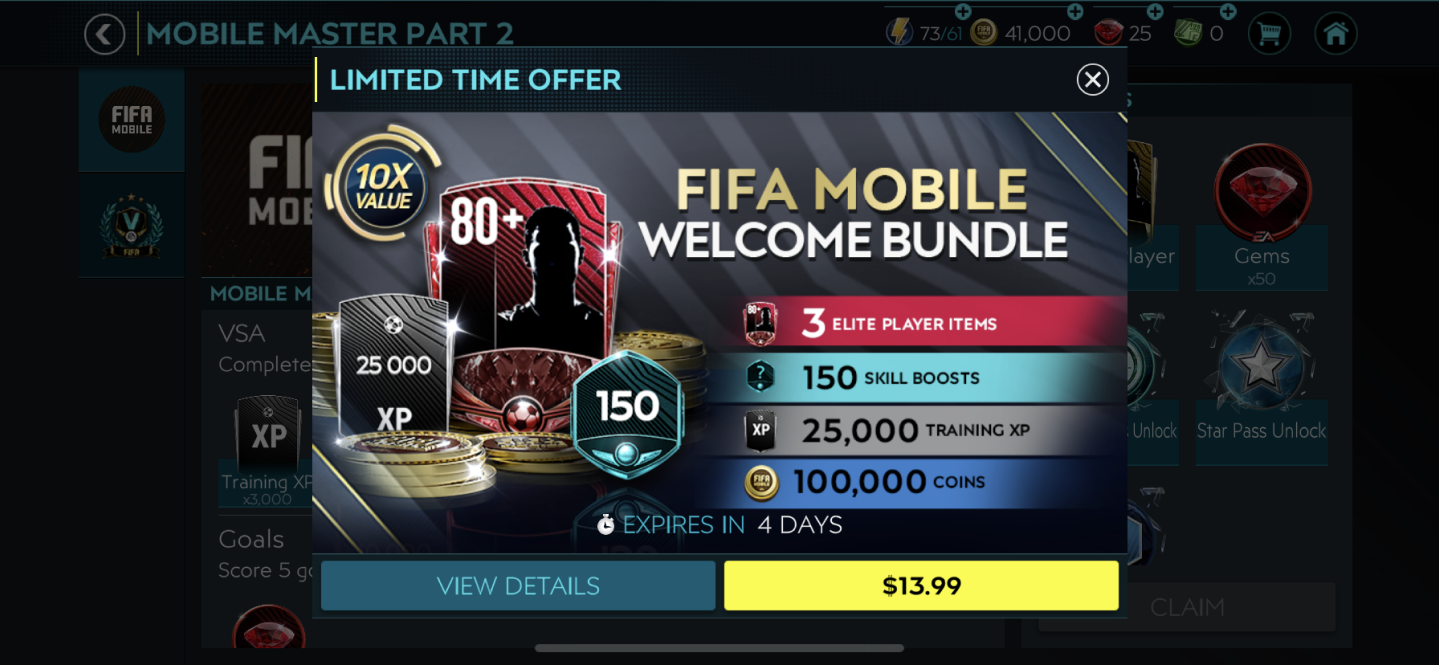
Existing Welcome Bundle

Recommendation Proposal
Success Metrics
We received positive client commendation from EA’s User Experience Design Director and User Experience Designers on our presentation and provided validity that the findings were quite similar to their internal User Research team. They also provided constructive feedback for our presentation which ranged from including sample questionnaire questions in the presentation and to provide some more statistical backing when telling a story in our presentation.
Reflection
This was one of my favourite projects because I have always dreamed of being able to work in the games industry and this was a step in the right direction by being able to work on a student client-focused project with EA, one of the largest video game developers. I am super grateful for the support provided by the UX Team and for the learning opportunity! I learned a lot about being to conduct an user research study from scratch by determining the clients’ needs, forming design evaluation goals, and then forming a self-directed study methodology. This was a challenge to conduct the study remotely during the pandemic and then ensure that our team did not take on too large of a project scope due to the constrained timeline of 3 weeks, however, our team adapted by researching best practices on remote user testing sessions as well as constantly readjusting the timeline and reprioritizing the major components that were necessary for the successful completion of the user evaluation study.
